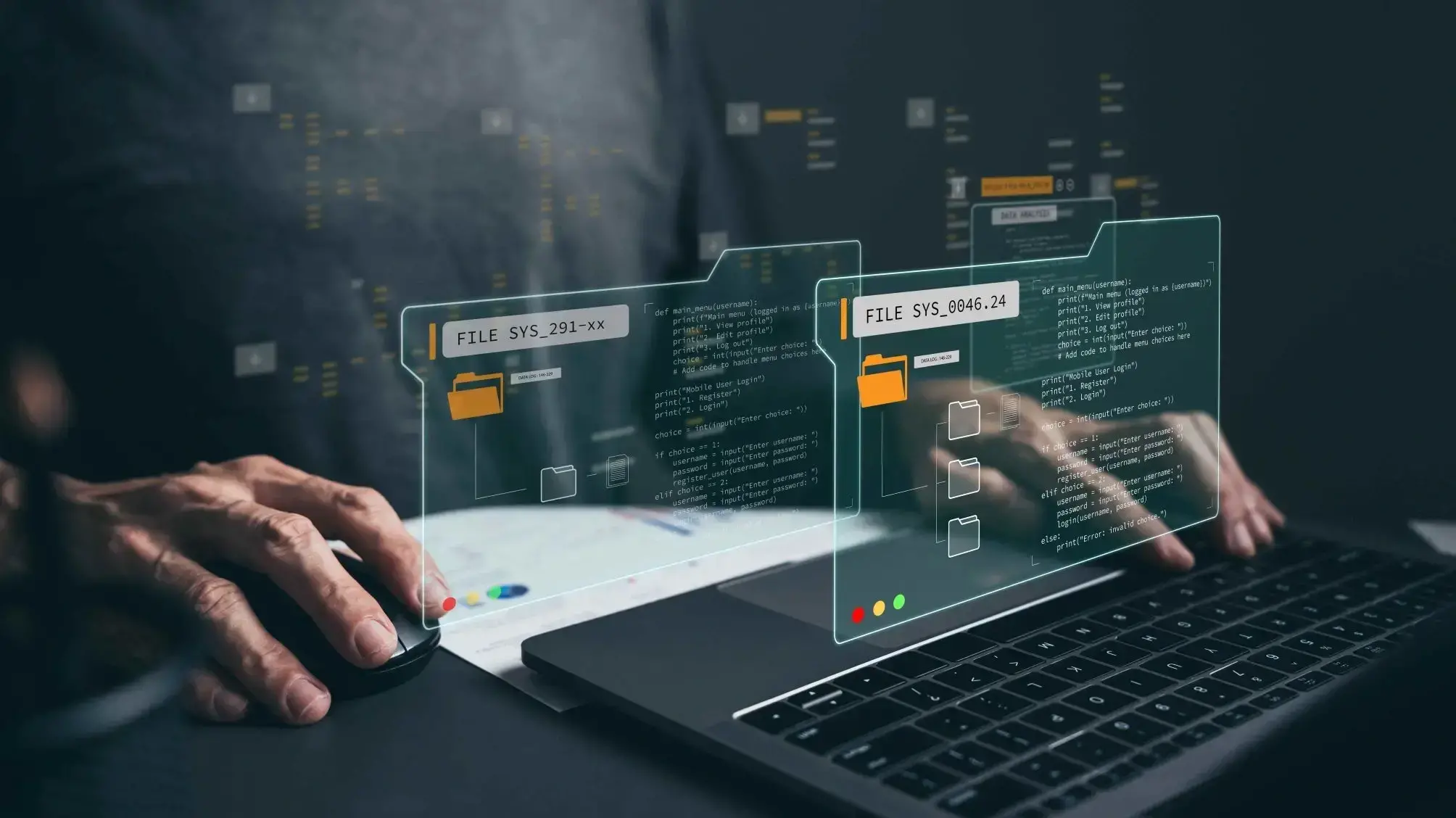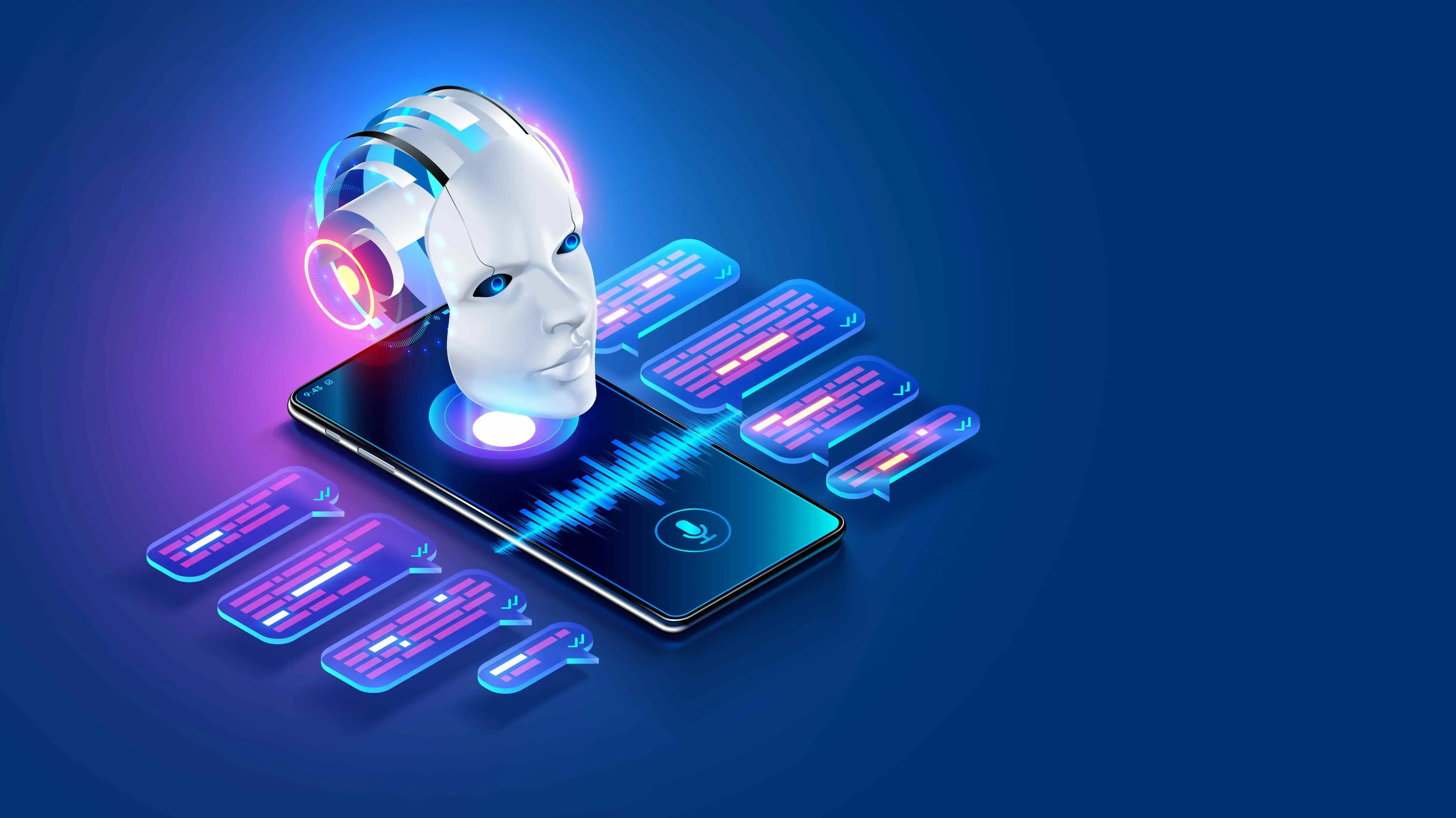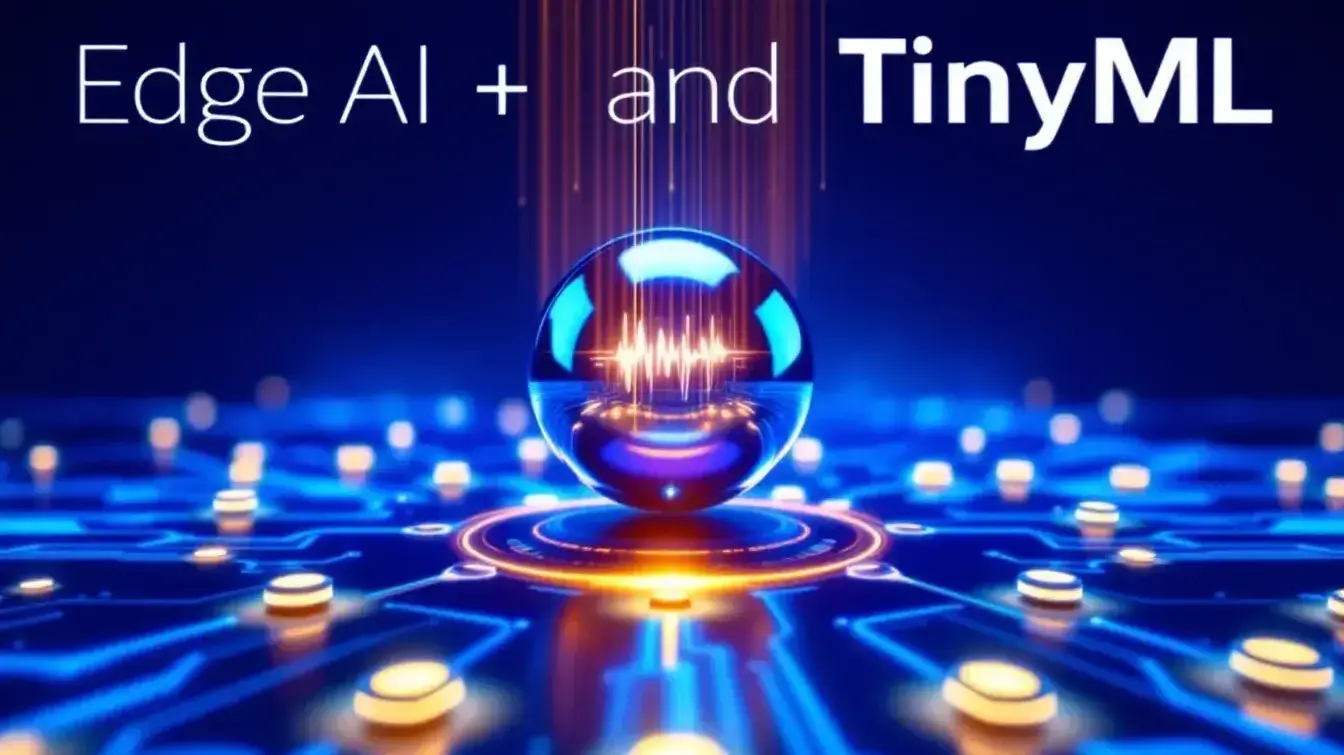Artificial Intelligence is no longer confined to the cloud. It is now being deployed directly on everyday devices, closer to where data is generated. This shift toward edge-first intelligence represents a fundamental change in how AI systems operate, prioritizing speed, efficiency, and privacy.
As this evolution progressed, the need to support AI on resource-constrained hardware gave rise to TinyML, which enabled low-power, real-time processing on devices as small as a coin. Edge AI and TinyML power smarter systems in places the cloud simply can not reach, from remote sensors to embedded health monitors.
What is Edge AI?
Edge AI is the practice of running artificial intelligence (AI) algorithms directly on edge devices such as smartphones, cameras, sensors, or IoT devices, without relying on cloud servers.
For example, a smart security camera that detects motion or identifies people locally without sending footage to the cloud uses Edge AI. This enables faster, more private, and energy-efficient decision-making, especially in real-time scenarios.
Characteristics of Edge AI
Local Processing: AI tasks such as image recognition or anomaly detection are executed directly on the device, reducing reliance on remote servers.
Real-Time Decision-Making: Edge AI significantly reduces latency, allowing devices to respond instantly. This is critical for time-sensitive applications like autonomous vehicles or industrial robots.
Enhanced Privacy and Security: Because data is analyzed on-device, there's less need to transmit sensitive information, minimizing the risk of data breaches or unauthorized access.
Offline Functionality: Edge AI can operate without constant internet access, making it ideal for remote locations, mission-critical systems, or areas with unreliable connectivity.
Improved Energy Efficiency: By eliminating the need to send large amounts of data to the cloud, Edge AI conserves bandwidth and reduces power usage, especially when paired with low-power hardware and optimized models.
What is TinyML?
TinyML (Tiny Machine Learning) is the process of running machine learning models on ultra-low-power microcontrollers and embedded devices with limited memory, storage, and processing power.
These models are compact and energy-efficient, enabling devices as small as a coin to operate for months or even years on a single battery.
For example, a motion sensor that recognizes specific gestures and turns on a light, without connecting to the internet, is powered by TinyML. It brings intelligence to everyday objects, especially where power, size, and connectivity are limited.
Characteristics of TinyML
Power Efficient: TinyML models are designed to run on milliwatts of energy, allowing devices to operate for extended periods on small batteries, ideal for portable and remote deployments.
Memory-Constrained Optimization: These models are heavily compressed (often <1MB) to fit within the tight memory and storage limits of microcontrollers.
Designed for Microcontrollers: TinyML works on basic hardware like 32-bit MCUs, which typically lack an operating system and have minimal processing capabilities.
Operates Without Internet: Inference happens entirely on the device, making TinyML useful in scenarios where connectivity is unavailable, unreliable, or not desired.
Instantaneous Response: Enables immediate, on-device decision-making for time-sensitive tasks like detecting movement, recognizing sounds, or triggering alerts.
Getting Started with TinyML Development
TinyML may sound complex, but with the right tools and a step-by-step approach, you can build and deploy smart models on tiny devices even with limited resources or ML experience.
1. Choose the Right Microcontroller
Start with a development board that supports low-power ML applications. Popular options include:
Arduino Nano 33 BLE Sense: Comes with built-in sensors (accelerometer, microphone, temperature, etc.) and is fully supported by TensorFlow Lite.
ESP32: Affordable and versatile, with Wi-Fi and Bluetooth, great for connected applications.
Raspberry Pi Pico: Powerful for its size but may require additional setup for ML. SparkFun Edge: Designed specifically for TinyML with ultra-low-power performance.
Choose a board based on your use case (e.g., audio processing, motion detection, remote sensing) and available sensor support.
2. Set Up the Development Environment
To begin coding and deploying your first model:
- Install Arduino IDE or PlatformIO depending on your workflow preference.
- Add the required board packages (e.g., Arduino SAMD, ESP32 cores).
- Install the TensorFlow Lite for Microcontrollers library via the Library Manager.
Edge Impulse is also a great no-code/low-code platform for building TinyML projects with guided tutorials and data collection tools.
3. Train and Convert a Model
Use a lightweight dataset to train a simple model using TensorFlow (e.g., for gesture recognition or keyword spotting). After training:
- Convert the model to a
.tfliteformat. - Use tools like xxd or Edge Impulse's built-in conversion to turn it into a C array for microcontroller integration.
4. Deploy and Test
Upload the model to your microcontroller and connect it to sensors. Start with a basic “Hello World” example like:
- LED control using a sine wave model
- Motion classification from accelerometer data
- Voice-triggered commands (e.g., yes/no)
Use the Serial Monitor or onboard LEDs to visualize model behaviour and debug performance.
5. Optimize for Performance
Once working, reduce power consumption and improve speed by:
- Applying quantization to the model
- Adjusting sampling rates and inference intervals
- Using sleep modes or event-driven inference triggers
Deployment and Optimization Tips

1. Optimize the Model for Size and Speed
Before deploying your model to a microcontroller, apply optimization techniques to reduce size and improve performance. Use quantization to convert 32-bit floating-point weights to 8-bit integers, significantly lowering memory usage and speeding up inference.
Apply pruning to remove less important connections in the neural network, and consider knowledge distillation to train a smaller model that mimics a larger one’s behaviour while requiring fewer resources.
2. Design with Power Efficiency in Mind
Power consumption is critical for battery-powered devices. Implement event-based inference, where the model only runs when triggered by sensor input, such as motion or sound. Activate deep sleep modes when the device is idle, and set inference intervals just high enough to meet performance needs without unnecessary energy use.
3. Minimize Memory and Storage Requirements
Microcontrollers operate with limited RAM and flash storage. Use TensorFlow Lite for Microcontrollers, which avoids dynamic memory allocation and is tailored for such environments. Store model weights in flash memory, and keep data preprocessing steps simple and lightweight to conserve both processing power and memory.
4. Measure Performance with Profiling Tools
Use profiling tools to understand how your model performs on actual hardware. The Arduino Serial Monitor can help track inference time, while hardware tools like the Otii Arc or Nordic Power Profiler Kit measure energy consumption. Platforms like Edge Impulse also offer integrated power and performance profiling features for supported boards.
5. Benchmark and Continuously Improve
After deployment, collect metrics such as inference latency, memory footprint, and battery drain to assess how well your model is performing. Use this data to refine your architecture, adjust hardware settings, or retrain with more efficient parameters. Optimization is often iterative; each adjustment brings you closer to a stable, high-performing edge AI application.
Key Differences Between Edge AI and TinyML
| Feature | Edge AI | TinyML |
|---|---|---|
| Target Hardware | Smartphones, edge servers, TPUs, NPUs | Microcontrollers (MCUs), ultra-low-power devices |
| Model Size | Medium to large | Very small (typically <1MB) |
| Power Consumption | Moderate | Extremely low (can run on coin cell batteries) |
| Processing Capability | High (can handle complex tasks like vision) | Limited (simple models like keyword spotting) |
| Use Case Examples | Smart assistants, surveillance, and real-time video | Wake word detection, motion sensing, predictive triggers |
| Internet Dependency | May work offline, but is often connected | Designed for fully offline functionality |
| Frameworks Used | TensorFlow Lite, PyTorch Mobile | TensorFlow Lite for Microcontrollers, Edge Impulse |
| Typical Devices | Raspberry Pi, smartphones, NVIDIA Jetson | Arduino Nano, ESP32, SparkFun Edge |
| Primary Goal | Bring AI closer to the data source for speed/privacy | Run ML in ultra-constrained, battery-powered environments |
Why Edge AI & TinyML Matter in Modern Tech
Enables Real-Time Intelligence: On-device processing allows immediate responses to data inputs vital for applications like autonomous systems, safety monitoring, and gesture control.
Protects User Privacy: Data remains on the device, minimizing exposure to third parties and reducing the risk of breaches or unauthorized access.
Minimizes Latency: Local computation removes the delays caused by sending data to the cloud, ensuring faster performance in time-critical scenarios.
Operates Without Internet: Devices can function independently of connectivity, making them reliable in remote, rural, or unstable network environments.
Extends Battery Life: TinyML’s low-power design enables long-term operation on small batteries, reducing maintenance for IoT deployments.
Core Technologies Powering Edge AI & TinyML

1. Microcontrollers (MCUs): TinyML models typically run on ultra-low-power microcontrollers like the Arduino Nano and ESP32, which operate with limited RAM and no operating system, making them ideal for compact, battery-powered devices.
2. Edge AI Accelerators: For tasks that require more processing power, devices such as Google Coral (Edge TPU) and NVIDIA Jetson Nano offer dedicated acceleration, enabling faster inference while keeping data local.
3. Neural Processing Units (NPUs): Many smartphones and smart devices now come with built-in NPUs that efficiently handle AI workloads, balancing performance with battery conservation for advanced edge applications.
4. Lightweight Machine Learning Frameworks: Frameworks like TensorFlow Lite for Microcontrollers and PyTorch Mobile provide streamlined tools that allow developers to train and deploy ML models on resource-constrained devices without unnecessary overhead.
5. Model Optimization Techniques: Techniques such as quantization, pruning, and knowledge distillation help shrink model size and improve inference speed, making them suitable for devices with limited memory and compute capacity.
6. Integrated Sensor Support: TinyML applications often rely on real-time data from sensors such as motion detectors, microphones, or temperature probes to trigger on-device inference and actions without cloud dependency.
7. Deployment Toolchains: Platforms like Arduino IDE, PlatformIO, and Edge Impulse simplify the end-to-end workflow of developing, testing, and deploying TinyML models to embedded hardware.
8. Embedded Software Libraries: Libraries such as CMSIS-NN and uTensor offer highly optimized code for executing neural network operations efficiently on microcontrollers, ensuring smooth performance even in tight resource environments.
Use Cases & Applications
Edge AI and TinyML are enabling smarter, faster, and more efficient systems across industries by pushing intelligence directly to devices. Below are key areas where they are making a real-world impact.
1. Healthcare: Wearables and portable devices now use TinyML to monitor heart rate, detect irregular breathing, or flag early signs of illness all in real time, without needing cloud access. This allows for continuous patient monitoring and personalized alerts, especially in remote or underserved areas.
2. Agriculture: Smart farming systems equipped with soil sensors and crop monitors use on-device ML to assess conditions like moisture levels or pest presence. These insights help farmers optimize irrigation, fertilization, and pest control, improving yields while conserving resources.
3. Smart Cities: Edge AI powers real-time traffic management, noise monitoring, and environmental sensing. Localized processing enables quick responses, such as adjusting traffic lights or alerting authorities to rising pollution, without relying on centralized systems.
4. Industrial IoT (IIoT): In factories and industrial settings, TinyML-enabled sensors perform predictive maintenance by detecting subtle changes in vibration, temperature, or sound, preventing costly breakdowns and reducing downtime.
5. Consumer Electronics: Devices like smart speakers, fitness trackers, and home appliances use TinyML for voice command recognition, gesture control, and automation. These features run efficiently on-device, improving responsiveness and preserving user privacy.
6. Environmental Monitoring: TinyML supports long-term data collection in remote or off-grid locations, such as wildlife habitats, forests, or oceans. Sensors detect patterns or anomalies like temperature spikes or unusual movement and trigger alerts in real time.
Benefits and Limitations
Benefits
Limitations
Benefits
Real-Time Performance: By processing data locally, devices can respond instantly without waiting for cloud communication. This is critical for applications like gesture recognition, safety systems, and autonomous control.
Enhanced Privacy: Sensitive data never leaves the device, reducing exposure to cyber threats and aligning with stricter data protection regulations.
Offline Functionality: Devices can operate without internet access, making them reliable in remote areas or during network outages.
Energy Efficiency: TinyML models are designed to run on ultra-low-power microcontrollers, enabling long battery life, ideal for IoT devices deployed in the field.
Reduced Bandwidth and Costs: Local inference limits the need for constant data transmission, saving bandwidth and reducing cloud processing costs.
Limitations
Limited Model Complexity: Microcontrollers have restricted memory and processing power, so only lightweight models can run efficiently.
Storage and Memory Constraints: Most TinyML devices operate with just a few hundred kilobytes of RAM and storage, which limits the size and scope of AI models.
Challenging Updates and Maintenance: Updating firmware or ML models across a distributed network of edge devices can be logistically difficult without a robust OTA (Over-the-Air) system.
Narrow Use Cases: TinyML is best suited for focused tasks like wake-word detection or sensor data analysis. Complex, multi-layered AI tasks still require more powerful systems.
Hardware Compatibility and Fragmentation: With many different boards and chipsets, ensuring compatibility and optimized performance across hardware can be a challenge.
Future Trends in Edge AI & TinyML
1. Federated Learning for Private On-Device Training
With increasing concerns around data privacy, federated learning allows devices to collaboratively improve shared models without transmitting personal data. Each device trains locally and contributes encrypted model updates, making this approach ideal for sensitive domains like healthcare and mobile applications.
2. Ready-to-Deploy AI Model Marketplaces
The rise of curated marketplaces is making it easier to access lightweight, production-ready models tailored for edge devices. Developers can quickly integrate models for common use cases such as voice detection or motion classification, without building them from scratch, speeding up time to deployment.
3. Neuromorphic Hardware for Event-Driven Intelligence
Inspired by the human brain, neuromorphic chips process information through spiking neural networks that react only when needed. This enables extremely efficient, real-time inference for sensory-driven tasks, with minimal energy usage, ideal for vision, sound, and environmental monitoring.
4. Built-In AI Acceleration on Microcontrollers
Manufacturers are embedding dedicated ML processing units directly into low-power chips, enabling more complex models to run efficiently on minimal hardware. This unlocks new potential for real-time classification, anomaly detection, and multi-sensor fusion in compact edge devices.
5. Edge–Cloud Synergy for Smarter Systems
Rather than operating in isolation, future AI systems will coordinate between edge and cloud environments. Real-time inference will happen locally, while heavier tasks like retraining and cross-device analytics are handled in the cloud, creating an adaptive, resource-balanced architecture.
6. Stronger Focus on Security and Model Transparency
As edge AI is adopted in safety-critical applications, there will be increased demand for explainable AI, secure update mechanisms, and tamper-resistant deployment strategies. Ensuring model behaviour is understandable and auditable will become a baseline requirement.
These trends signal a shift toward more autonomous, privacy-conscious, and efficient edge intelligence. As the ecosystem matures, TinyML and Edge AI will become foundational technologies for the next generation of connected experiences.
Conclusion
Edge AI and TinyML are reshaping the future of intelligent computing, bringing AI out of the cloud and into everyday devices. From wearables that monitor health in real time to sensors that help farmers protect crops, these technologies are enabling smarter, faster, and more private solutions at the edge.
By understanding the core technologies, use cases, and best practices and staying informed on emerging trends like federated learning and on-chip AI, developers, businesses, and innovators can tap into the full potential of edge intelligence.
As devices become smaller, more connected, and more powerful, the edge won’t just be where AI lives, it will be where AI leads.
Frequently Asked Questions
How does edge computing enhance AI capabilities in resource-constrained environments?
Edge computing improves AI capabilities by enabling real-time data processing on resource-constrained edge devices. This reduces reliance on cloud computing and provides immediate feedback with lower power consumption.
What role do the Edge AI Foundation and TinyML Foundation play in advancing technology?
The Edge AI Foundation and TinyML Foundation provide technical insights and promote standards to support software systems designed for embedded systems, ensuring efficient running of machine learning algorithms in various industries.
Why are low-power devices important for Tinyml deployment?
Low-power devices are ideal for Tinyml deployment because they allow processing data locally with high performance and power efficiency, especially in Edge AI applications with a dedicated function.
How do edge devices support distributed computing for the Internet of Things (IoT)?
Edge devices in the Internet of Things enable distributed computing by keeping data localized, reducing dependence on a central server or other devices, and supporting cost efficiency across AI applications.

Yetunde Salami is a seasoned technical writer with expertise in the hosting industry. With 8 years of experience in the field, she has a deep understanding of complex technical concepts and the ability to communicate them clearly and concisely to a wide range of audiences. At Verpex Hosting, she is responsible for writing blog posts, knowledgebase articles, and other resources that help customers understand and use the company's products and services. When she is not writing, Yetunde is an avid reader of romance novels and enjoys fine dining.
View all posts by Yetunde Salami




















